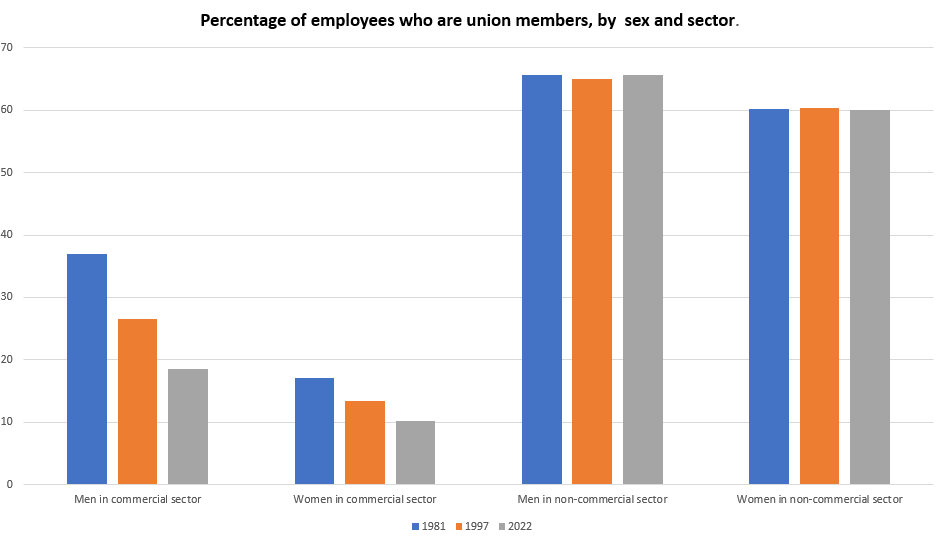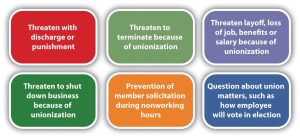8.5 Labour Relations
Employees have very little power regarding their relationship with companies’ management as separate individuals. However, when organized as a group, employees gain some power and can leverage it to negotiate with their employer. This section discusses the process a group of employees must undertake to become an official union.
Unions in Canada
Since the beginning of unionization in Canada, it has seen many changes. As the economy has shifted from manufacturing to the service sector over 40 years, and technology has impacted the world of work, so have unions. Unions impact wages by increasing wages and retirement pensions. They can affect how companies hire employees and how many employees (more or less employees). Most recently during the pandemic, unions were actively negotiating working from home. Unionization has dropped primarily because of the shift from manufacturing to the service sector.
For both men and women, unionization fell in the commercial sector (industries outside educational services, health care and social assistance, and public administration) but remained stable in the non-commercial sector. For example, the percentage of men who are union members in the commercial sector fell from 31% in 1981 to 19% in 2022. However, the percentage of men who are union members in the non-commercial sector remained stable at about 66%.Note

The government in Canada sets the framework for unions and management through laws and role as an employer. The federal government and provincial governments have their own regulations. Jurisdiction over labour relations has impacts on HR departments. The Canadian government has jurisdiction over airlines, railways, banks and federal agencies. All other companies fall under provincial regulations. Recently, unions have been critical of government interference in collective bargaining. The Green Party of Canada has criticized the federal government by stating, “Many times the government has used its legislative power to undermine collective bargaining and interfere with the free nature of collective bargaining. The Post Office, Air Canada, and the railways are examples. When a government uses its political agenda to control working conditions and wages, to its benefit, it essentially is using its workers as political pawns” (Green Party of Canada, n.d., para. 9).
Process of forming a union
The creation of a union follows a fairly strict process. First, an established union may contact employees and discuss the possibility of a union, or employees may contact a union on their own. The union will then help employees gather signatures to show that they want to be part of a union. The union must show signatures from over 35 percent of the organization’s employees to hold an election. Following are the steps in the unionization process.
- Union and employees make contact. As a result of employee dissatisfaction, union and employees make contact and discuss the possibility of joining forces.
- Initial Organization Meeting. An initial meeting with the union is scheduled to gather employee support.
- Formation of organizing committee Local union leadership is identified. Its objectives are to organize a campaign to obtain the signatures of a majority of workers willing to join the union.
- Application to Labour Relations Board. Once a majority of these signatures are gathered, the workers can apply for official recognition to the Labour Relations Board
- The Board issues the certificate. After checking the process and the signatures, the Board certifies the union.
- Election of the bargaining committee and contract negotiation. After being certified, the first step for the newly formed union is to elect a bargaining team tasked with negotiating a contract with the employer.
Unions approach prospective members with promises like higher pay, better health insurance, and more vacation time. Not surprisingly, management may resist unions because they generally add to business costs. As a result, the union organizing process can be very delicate because most employers feel the constraints of having a union organization are too great. Collective bargaining can put management at odds with its employees.
Legal protection exists for employees considering unionization, and HR and management should be educated on what can legally and illegally be said during this process. It is illegal to threaten or intimidate employees when discussing a union. Employers cannot threaten job, pay, or benefits loss due to forming a union. The image below includes what to avoid when employees consider unionization.

- Threaten with discharge or punishment.
- Threaten to terminate because of unionization.
- Threaten layoff, loss of job, benefits or salary because of unionization
- Threaten to shut down business because of unionization
- Prevention of member solicitation during nonworking hours
- Questions about union matters, such as how employees will vote in the election
Despite all of the above, some organizations will go to great lengths to prevent the unionization of their workforce. You can read about one example: Walmart wrong to close Quebec store after successful union drive, Supreme Court rules.
“10.2 Reasons for Unionization” and “10.4 Legislation and Unions” from Human Resources Management – 3rd Edition Copyright © 2023 by Debra Patterson is licensed under a Creative Commons Attribution-NonCommercial-ShareAlike 4.0 International License, except where otherwise noted.
“Unionization process” in Human Resources Management – 2nd Ontario Edition by Elizabeth Cameron is licensed under a Creative Commons Attribution-NonCommercial-ShareAlike 4.0 International License, except where otherwise noted.

